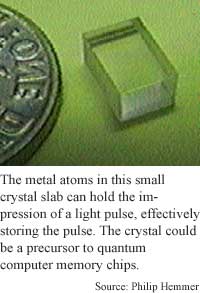
Crystal
stores light pulse
By
Eric Smalley,
Technology Research NewsA year ago, two research teams independently announced that they had stored light pulses in the atoms of gases and then reconstituted the stored pulses. A third research team has accomplished the same feat using a solid material, a crystal that could eventually be used to make quantum computer memory chips.
Quantum computers would theoretically be much faster than today's classical computers in solving certain problems like cracking secret codes, but are difficult to build because quantum information is extremely fragile.
Being able to store quantum information for relatively long periods of time would go a long way toward making practical quantum computers feasible. "Most quantum processors require storage," said Philip Hemmer an associate professor of physics at Texas A&M University. "For quantum storage, the advantages of the crystal [over a gas] are a much larger storage capacity, potentially much longer storage times, and the relative ease of incorporating [it] into a system," he said.
Hemmer's research team from the U.S. and South Korea was able to store light pulses in a crystal for a few tenths of a millisecond, which is comparable to what the previous experiments accomplished using gases, said Hemmer.
The researchers stored light in a yttrium silicate crystal with small amounts of the rare earth metal praseodymium added to it. Light doesn't travel through opaque matter because its photons are absorbed by the material's atoms.
The researchers fired a control laser beam into the crystal's atoms in order to overload them with photons. At the same time, they sent a weaker pulse of light of a different frequency into the crystal. The interaction between this weaker light pulse and the crystal's overloaded atoms introduced drag, which slowed the pulse to about 45 meters per second, or 100 miles per hour. Light travels through a vacuum at 186,000 miles per second.
When the researchers turned the control laser beam off, the slowed light pulse disappeared, but left an impression in the crystal's atoms. When the researchers turned the control beam back on, the pulse was reconstituted from the information stored in the atoms and it continued through the crystal.
The technique could eventually be used to store quantum information.
Quantum particles can be in one of two complementary states. For example, photons can be polarized vertically or horizontally and atoms can be spinning in one of two directions, up or down.
Using those states to represent the ones and zeros of digital information, the particles can serve as quantum bits, or qubits. The qubits that represent the output of a quantum processor could be transferred to photons that could then be sent to a quantum memory chip where the qubits could be transferred to atoms in the chip for storage.
The researchers have a ways to go before they produce a quantum memory chip. In their experiment, they stored a light pulse consisting of many photons. "The next steps will be to attempt storage of single photons, and to improve the efficiency to be close to 100 percent," said Hemmer. It could be 10 years before the light storage technique is used in practical applications, he said.
"Slow light and light storage in solids are very exciting," said David Phillips, a physicist at the Harvard-Smithsonian Center for Astrophysics. "This experimental demonstration brings us a step closer to the era of serious applications of the underlying physical concepts. While these materials still require cryogenic temperatures to show the coherence times necessary for light storage, perhaps more easily utilized materials will be developed in the future," he said.
Hemmer's research colleagues were Alexey Turukhin and Sudi Sudarshanam of the Massachusetts Institute of Technology, Selim Shahriar, now at Northwestern University, Joe Musser of Texas A&M University, Byoung Ham of the Electronics and Telecommunications Research Institute in South Korea. They published the research in the January 14, 2002 issue of the journal Physical Review Letters. The research was funded by the Air Force Research Laboratory, the Army Research Office, the Air Force Office of Scientific Research, and the Korean Ministry of Science and Technology.
Timeline: 10 years
Funding: Government
TRN Categories: Quantum Computing
Story Type: News
Related Elements: Technical paper, "Observation of Ultraslow and Stored Light Pulses in a Solid," Physical Review Letters, January 14, 2002
Advertisements:
January 30, 2002
Page One
Crystal stores light pulse
Rocket chips to propel small satellites
Computers sort gender in a binary world
Quantum network withstands noise
DNA computer readout glows

News:
Research News Roundup
Research Watch blog
Features:
View from the High Ground Q&A
How It Works
RSS Feeds:
News
Ad links:
Buy an ad link
| Advertisements:
|
 |
Ad links: Clear History
Buy an ad link
|
TRN
Newswire and Headline Feeds for Web sites
|
© Copyright Technology Research News, LLC 2000-2006. All rights reserved.